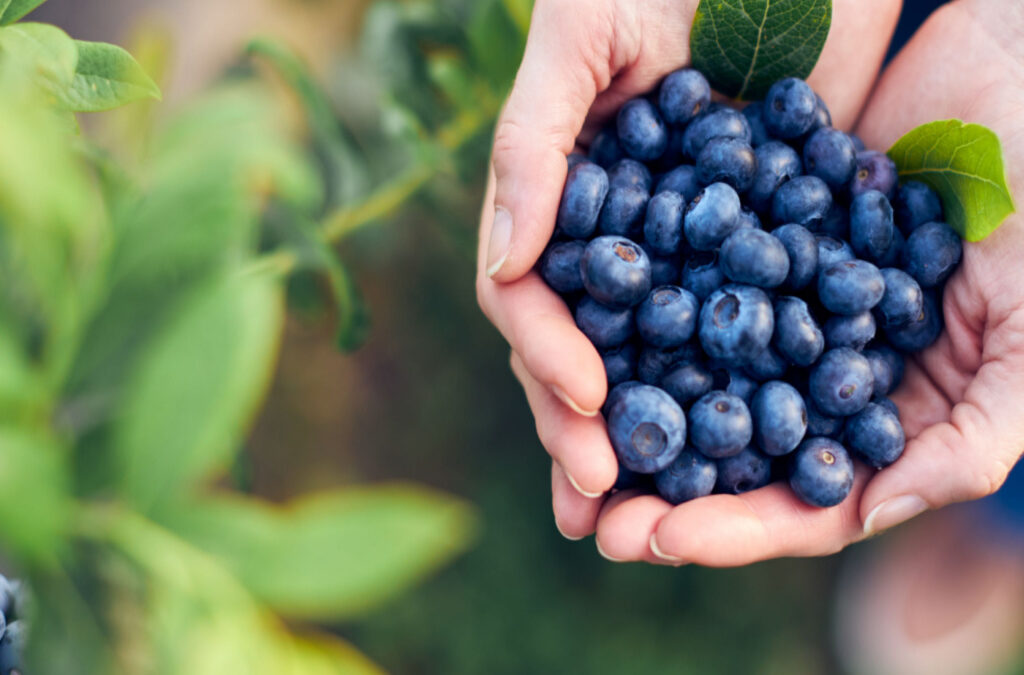This week I was fortunate enough to make a trek to a beautiful 12-acre USDA certified organic blueberry farm to pick and purchase berries. All in, my friend Karen and I picked 70 pounds of blueberries! So, what does one do with a 35 pound share? LOTS of things. Fist off I “gifted” my friend Bobby 12 pounds when he said that blueberry is his absolute favorite fruit. The rest? I’ve divided into freezing, canning, dehydrating, and making one of my favorite, versatile concoctions, a Shrub. More about that later, along with a recipe and a few ideas on what to do with a Shrub.
Not only are blueberries delicious, and by many, considered a “superfood,” they also contain large amounts of nutrients such as fiber, potassium, and vitamins K and C. There are many science-backed benefits of blueberries, including boosting antioxidant levels, reducing cholesterol, and improving insulin activity. They are rich in polyphenols which inhibit oxidation.
What does that have to do with bone health? As we age, the body becomes more susceptible to oxidative damage. This damage has shown to increase bone turnover by causing an imbalance between the cells responsible for bone formation (osteoblasts) and resorption (osteoclasts.)
Antioxidants are known to inhibit and/or minimize the effects of oxidative stress. Studies have demonstrated strong evidence of associations between polyphenol intake, reduced fracture risk, increased bone formation markers, and increased bone mineral density. Berries, which are naturally rich in anthocyanins have been associated with increased ability to reduce oxidative stress. Evidence in several studies showed cranberry and blueberry consumption to prevent and reduce bone loss This study believes berry consumption may be a good dietary strategy to lessen the effects of age-related bone loss and decrease the risk of osteoporosis. If you’re a bit of a geek like me, here is the link1 to the study PubMed Study
OK, back to Shrubs. I was introduced to them a few years ago as a fun cocktail/mocktail ingredient addition. But I soon learned that Shrubs are way more than just about cocktails. Shrubs have been around for centuries and are considered “drinking vinegars.” They have been used as tonics and cordials in Asia for hundreds of years. Shrubs were commonly consumed in 18th century America as a way to use/repurpose scraps of food prior to refrigeration. It is speculated that the addition of shrubs to “fizzy water” in colonial times is where the idea of sodas originated. So here’s what’s “cookin” at my house:
Blueberry Shrub
Ingredients:
- 1 part blueberries (a “part” can be any measurement; a cup, a quart, a gallon)
- 1 part raw organic apple cider vinegar
- ½ part raw local honey
Directions:
Put berries in a wide mount glass jar. “Muddle” the berries (smoosh them up) and cover with the apple cider vinegar. Cover jar with a non-metal lid (vinegar can corrode the lid.) If you only have a metal lid, no problem. Just place a piece of waxed paper between the lid and the container and screw the lid on. Label the jar and store in a cool dark place for 1 – 2 weeks, shaking daily.
Strain off the berries (either discard or use berries in other dishes.) Stir in the honey. Store in the refrigerator for up to a year.
Blueberry Shrub Uses
- Delicious and refreshing as a beverage, served 1 part shrub to 4 parts sparkling water. Adding a little fresh mint, pomegranate juice or ginger slices is nice for variety of flavors.
- For a cocktail, add an ounce or two to of your favorite alcohol, like gin, vodka or white rum.
- Use in a salad dressing. One of my favorites is to “massage” (yes, just rub it in with your fingers) torn kale with a light drizzle of extra virgin olive oil, let it rest a bit to soften the kale (good source of vitamin C, calcium & vitamin K1) Then drizzle with the shrub, and toss in some blueberries, thinly sliced red onion and top with slivered almonds (good source of magnesium, fiber & vitamin E) and crumbled blue cheese (good source of calcium & vitamin K2)
Let me know if you give this a try and how you like it!
Source:
- Hubert PA, Lee SG, Lee SK, Chun OK. Dietary Polyphenols, Berries, and Age-Related Bone Loss: A Review Based on Human, Animal, and Cell Studies. Antioxidants (Basel). 2014 Mar 11;3(1):144-58. doi: 10.3390/antiox3010144. PMID
Information curated and formulations created by Susan Williams RH(AHG) susan@ipivot-now.com
Although these recipes are considered gentle and safe always test a small amount to check from any type of allergic reaction before using . We are all unique and need to respect that. Disclaimer: I am not a medical doctor, and no information here is a substitute for medical advice; I’m a registered herbalist RH(AHG), a board certified health and wellness coach (NBC-HWC) and I hold a master’s degree in education (MEd). No content I create on any platform or in any way is meant to treat, cure, diagnose, or prevent any disease or illness. Please be sure to obtain medical advice from a medical professional before using herbs, supplements, or essential oils. The FDA doesn’t regulate herbs, supplements, or essential oils; thus, nothing included here has been evaluated by the FDA. Website links included here are not affiliate links and I am in no way compensated. They are provided for your convenience only.

